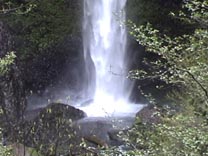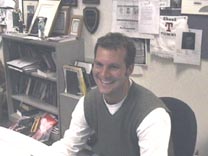Harney County Cattle Grazing Study
Spring Field Trip 2002
OREGON BEEF COUNCIL
At the Oregon Beef Council we went in and sat at their office. Dianne Johnston the executive director talked to us as well as Dana Peterson, who is the Promotion director. We learned that chicken is beef's main competitor, followed by pork, turkey, and fish. The beef council is trying to promote beef as a main holiday meal. One of the their main promotions is the Beef Blitz. Members of the Oregon Cattlewomen pair up with volunteers from high schools and Oregon State University. They then cook a beef recipe for students in grade schools, junior high, or high schools. You can get to their website at www.orbeef.org. They give a lot of information and even beef recipes. It was a lot of fun.
BONNEVILLE DAM AND HATCHERY
The first stop that we made on the trip was the Bonneville dam. It was a very educational place to visit. We learned about chinook, salmon, and steelhead and how they travel up the fish ladder. We also learned about their population and how the dams affected their migration. Seeing the sturgeon ponds was also exciting.
| Our first look at Bonneville Dam. (Photo: Jimmy Zamora) | |
| Students standing next to Bonneville Dam Turbine. (Photo: Marlon Dick) | |
 | VIDEO: Students and Fish. |
THE COLUMBIA RIVER GORGE
| Becka, Mandy,and Tarah walking by a water stream. (Photo: Jimmy Zamora) |
| Gorge and Crown Point. (Photo: Eric Garner) |
The gorge was created by Bretz floods[Allen and others 1986]. The crests of the floods dropped in elevation from 1000 feet at the Dalles to 700 feet at Crown Point.
Transportation of cattle through the gorge was difficult! Cattle could fall off of the cliffs, or be swept away by the swift rivers. Cattle were trailed over the Barlow Road to the stockyards to avoid the gorge. Later on, the railroad was built to help transport cattle and other goods to Portland.
| Lunch (left to right): Bob, Carol, Christa, Eric, Jamie, Becka, Mandy, and Tarah. (Photo: Jimmy Zamora) | |
| Eric, Marlon, Jamie, and Christa on top of Laourell Falls. (Photo: Jimmy Zamora) | |
 | VIDEO: Waterfalls |
THE OREGONIAN
The Oregonian is the largest daily news paper and also the oldest in the Pacific Northwest. The tour of the Oregonian started off with a briefing on public outreach presented by Stephanie Oliver (who handles public affairs) followed by a quick look at what goes on in the news rooms at the Oregonian headquarters. We also learned what it takes to present a news paper to the public each and every day. Stephanie, also introduced us to Jason Quick who is one of several sports writers that covers the Trail Blazers games. He said a quick hello, and gave us his insight on the upcoming Portland / L.A game .
| Stephanie Oliver giving us a tour of the Oregonian Headquarters. (Photo: Jimmy Zamora) | |
 | VIDEO: Jason Quick |
JEFFERSON HIGH SCHOOL
On the early morning of April 19, 2002 we headed out to Jefferson High School in Portland, Oregon to give a presentation to Mr. Mike Rooney’s physical science class about grazing and every day life in Harney County. We opened by talking a little about the history and ways of life and how it differs with 350 miles between us. The students at Jefferson High were very entertained with the idea of early mornings, branding cattle, and slaughtering. In turn we also learned a lot about what they do everyday and how their lifestyle is. After the presentation Brian and Lisa (two of the students at Jefferson High) gave us a tour of the Jefferson High TV studio and other facilities in the school.
PORTLAND
SENATOR GORDON SMITH'S OFFICE
| Harney County Students in Senator Smith’s office. (Photo: Nana Lapham) | |
| View of Willamette river as seen from Senator Smith’s office. (Photo: Jimmy Zamora) |
OREGON STATE UNIVERSITY
OVERALL REVIEW OF THE FIELD TRIP
Overall the trip was great, we had SO much fun! Not only learning but also interacting with a variety of people. It was such a treat to be able to come to northwestern Oregon to learn a little bit about agriculture here and learning to put a web site together. It’s a great experience going and learning about things and seeing how different the landscape and terrain in agriculture differ from home. We have learned a lot that we can use later on in life. From things such as difference between rural and urban areas to how gross oysters are.